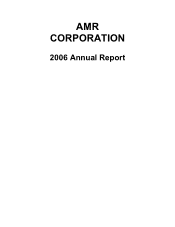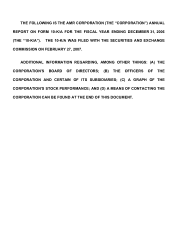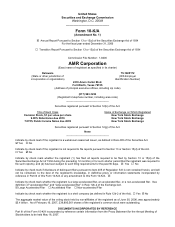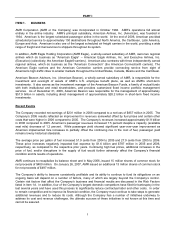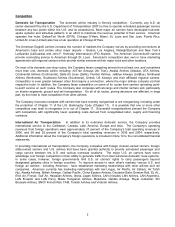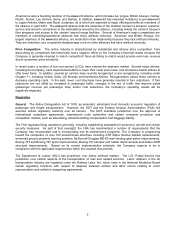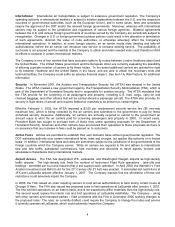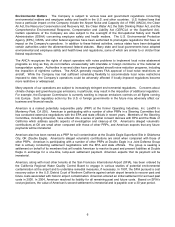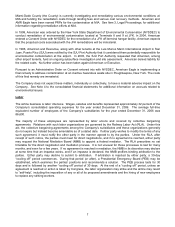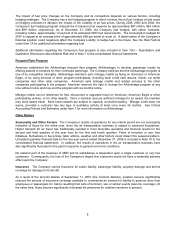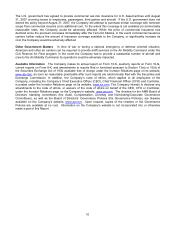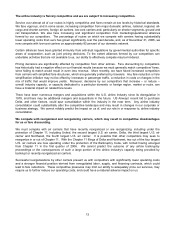American Airlines 2006 Annual Report Download - page 7
Download and view the complete annual report
Please find page 7 of the 2006 American Airlines annual report below. You can navigate through the pages in the report by either clicking on the pages listed below, or by using the keyword search tool below to find specific information within the annual report.
3
American is also a founding member of the oneworld alliance, which includes Aer Lingus, British Airways, Cathay
Pacific, Finnair, Lan Airlines, Iberia, and Qantas. In addition, oneworld has extended invitations to join oneworld
to Japan Airlines, Malev and Royal Jordanian, all of which are expected to begin offering benefits as members of
the alliance in April 2007. The oneworld alliance links the networks of the member carriers to enhance customer
service and smooth connections to the destinations served by the alliance, including linking the carriers' frequent
flyer programs and access to the carriers' airport lounge facilities. Several of American's major competitors are
members of marketing/operational alliances that enjoy antitrust immunity. American and British Airways, the
largest members of the oneworld alliance, are restricted in their relationship because they lack antitrust immunity.
They are, therefore, at a competitive disadvantage vis-à-vis other alliances that have antitrust immunity.
Price Competition The airline industry is characterized by substantial and intense price competition. Fare
discounting by competitors has historically had a negative effect on the Company’s financial results because the
Company is generally required to match competitors' fares as failing to match would provide even less revenue
due to customers’ price sensitivity.
In recent years, a number of low-cost carriers (LCCs) have entered the domestic market. Several major airlines,
including the Company, have implemented efforts to lower their costs since lower cost structures enable airlines to
offer lower fares. In addition, several air carriers have recently reorganized or are reorganizing, including under
Chapter 11, including United, Delta, US Airways and Northwest Airlines. Reorganization allows these carriers to
decrease operating costs. In the past, lower cost structures have generally resulted in fare reductions. If fare
reductions are not offset by increases in passenger traffic, changes in the mix of traffic that improve yields
(passenger revenue per passenger mile) and/or cost reductions, the Company’s operating results will be
negatively impacted.
Regulation
General The Airline Deregulation Act of 1978, as amended, eliminated most domestic economic regulation of
passenger and freight transportation. However, the DOT and the Federal Aviation Administration (FAA) still
exercise certain regulatory authority over air carriers. The DOT maintains jurisdiction over the approval of
international codeshare agreements, international route authorities and certain consumer protection and
competition matters, such as advertising, denied boarding compensation and baggage liability.
The FAA regulates flying operations generally, including establishing standards for personnel, aircraft and certain
security measures. As part of that oversight, the FAA has implemented a number of requirements that the
Company has incorporated and is incorporating into its maintenance programs. The Company is progressing
toward the completion of over 100 airworthiness directives including ATR Alpha thermal blanket replacements,
enhanced ground proximity warning systems, McDonnell Douglas MD-80 main landing gear piston improvements,
Boeing 757 and Boeing 767 pylon improvements, Boeing 737 elevator and rudder improvements and Airbus A300
structural improvements. Based on its current implementation schedule, the Company expects to be in
compliance with the applicable requirements within the required time periods.
The Department of Justice (DOJ) has jurisdiction over airline antitrust matters. The U.S. Postal Service has
jurisdiction over certain aspects of the transportation of mail and related services. Labor relations in the air
transportation industry are regulated under the Railway Labor Act, which vests in the National Mediation Board
certain regulatory functions with respect to disputes between airlines and labor unions relating to union
representation and collective bargaining agreements.

